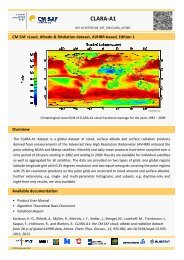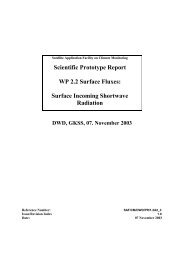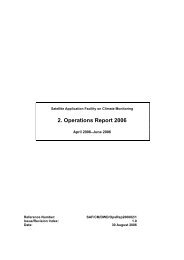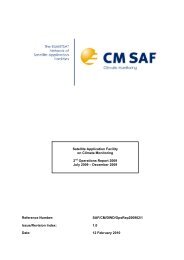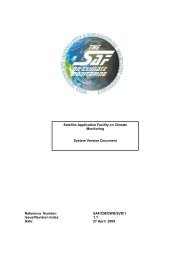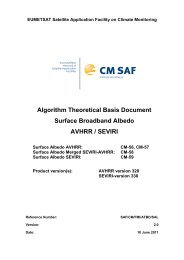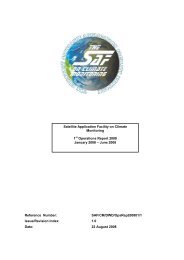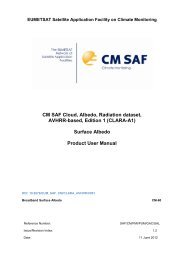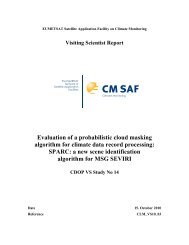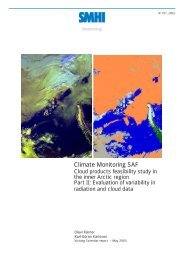Aerosol retrievals from METEOSAT-8 - CM SAF
Aerosol retrievals from METEOSAT-8 - CM SAF
Aerosol retrievals from METEOSAT-8 - CM SAF
Create successful ePaper yourself
Turn your PDF publications into a flip-book with our unique Google optimized e-Paper software.
<strong>SAF</strong> on Climate Monitoring Visiting Scientists Report Doc. No: 1.0<br />
Issue : 1.0<br />
Date : 4 October 2006<br />
Appendix C<br />
Clear sky observations and contribution of the temporal<br />
resolution of MSG/SEVIRI<br />
Dominique Jolivet and Didier Ramon (HYGEOS)<br />
&<br />
Jérôme Riedi and Jean-Marc Nicolas (LOA)<br />
The algorithm to separate cloud free <strong>from</strong> cloud contaminated or cloud filled pixels has been<br />
developed with the intention of being applicable globally without requiring ancillary data such as<br />
surface temperature or atmospheric profiles. Each test implemented within the algorithm has been<br />
designed based on fundamental physical differences (emissivity, spectral behaviour) between<br />
clouds and surface.<br />
Many lessons learned <strong>from</strong> the Moderate Resolution Imaging Spectroradiometer (MODIS),<br />
regarding discrimination between clouds and heavy aerosols events or sunglint for instance (spatial<br />
variability, spectral behaviour), have been taken into account in the design of this cloud detection<br />
scheme. However, the present algorithm shall not be considered as just a simplified MODIS-like<br />
cloud mask because : (i) some tests have been adapted and modified to account for the differences<br />
in spectral channels, calibration and/or spatial resolution and make them applicable to SEVIRI, (ii)<br />
the number of tests used is currently much smaller than the one used in the operational MODIS<br />
algorithm (Ackerman et al. 1998; Platnick et al. 2003) and (iii) the decision logic differs<br />
significantly <strong>from</strong> the one used for MODIS (http://www-loa.univ-lille1.fr/~riedi/).<br />
The input to the SEVIRI cloud detection algorithm consists of normalized reflectances <strong>from</strong> the<br />
visible (0.6 and 0.8 µm) and near-infrared (1.6 µm) channels, whereas brightness temperatures are<br />
used <strong>from</strong> the thermal infrared channels (3.8, 8.7, 10.8 and 12.0 µm). Additionally, the algorithm<br />
uses ancillary data on solar and viewing geometry and a land/sea map but none is required <strong>from</strong><br />
model reanalysis. There are spectral threshold and spatial coherence cloud detection tests that are<br />
different for land and ocean surfaces. The various tests implemented are grouped together in such a<br />
- 43 -



